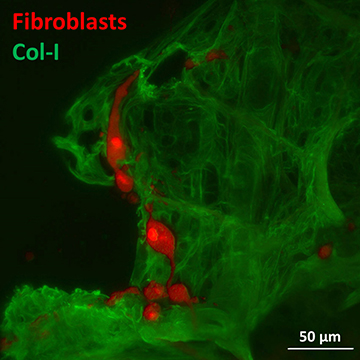DZL Project Stem Cell Research: How can we rebuild damaged lung tissue
to make transplants more successful?
ELD, End Stage Lung Disease, indicates diseases that lead to a definitive lung failure. Affected patients can survive only through a lung transplantation. The biggest problem are rejection reactions, which become chronic in about half of the patients after only five years.
The team around Dr. Gerald Burgstaller examines at CPC-M whether stem cells or precursor cells can serve to rebuild lung tissue that does not contain functional lung cells anymore? For this purpose, precision slices of human lung tissue were decellularized, all functioning cells were removed:

The tissue was then repopulated, re-cellularized with fibroblasts. Among other things, these cells help to rebuild tissue after injury. The result:
The human fibroblasts colonized the tissue easily and actively. Here in 3D and real-time, an additional staining leaves the cell-free tissue green and the fibroblasts appear red:

This observation suggests that suitable stem cells, known as induced pluripotent stem cells (iPS), can be used to rebuild damaged lung tissue. iPS cells can be obtained from fibroblasts by differential treatment with growth factors. This should now be further investigated. The goal: to produce transplantable lung tissue and to mitigate or even prevent chronic rejection reactions after lung transplantations.
Experience life on the smallest level, in motion, in color and in real time
How 4D Light Sheet Microscopy revolutionizes Imaging
Soft light, shallowly projecting from several sides: With the light-sheet fluorescence microscope, scientists can observe living organisms or tissue down to the nanoscale. This gentle imaging reduces the photo-toxicity - unpopular with researchers - the damage to the cells by light. In addition, the microscope is incredibly fast and accurate. This results in never seen shots, in color, 3D and in real time. However: The file sizes are also incredible. Big data that must then be managed, processed and merged.
The project is based on a cooperation with the Research Unit Lung Repair and Regeneration (LRR, director Melanie Königshoff) and a collaboration with Olmer Ruth and Martin Ullrich from the DZL site Hannover (BREATH).
Please note: Our scientists are conducting basic research, the project described here could only lead to a therapy or application in a few years. For information on current therapies or treatments for lung diseases, please visit lungeninformationsdienst.de.


